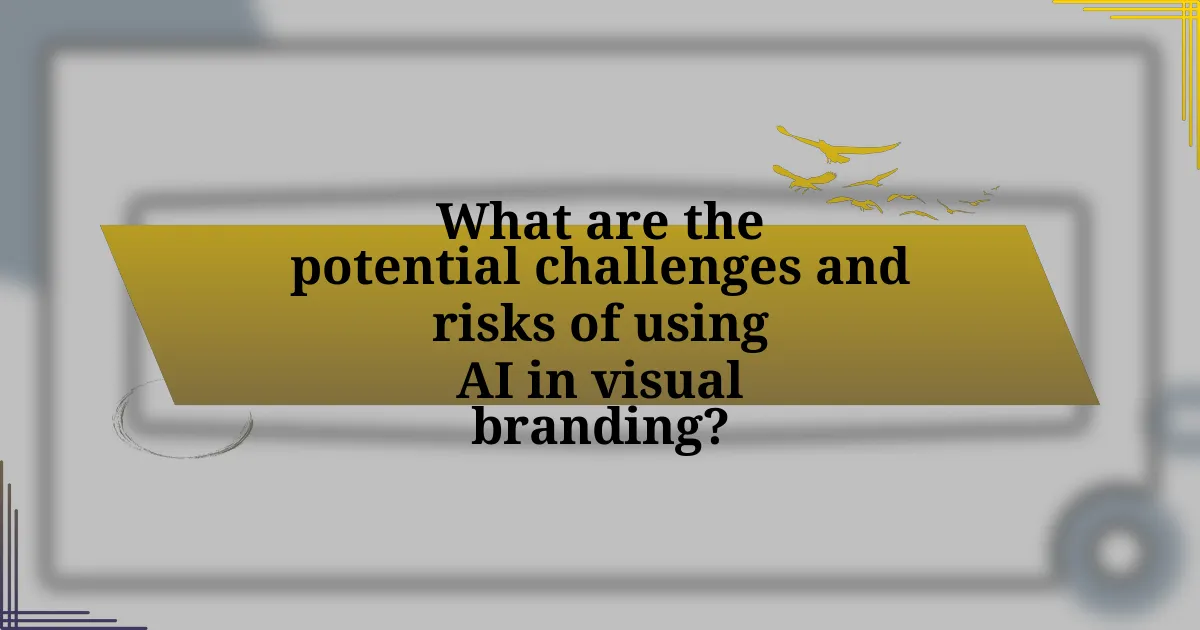The article examines the significant impact of artificial intelligence (AI) on visual branding strategies, highlighting how AI enhances personalization, efficiency, and data-driven decision-making. It discusses the transformation of traditional branding approaches through AI technologies such as machine learning, computer vision, and generative design tools, which enable brands to create tailored visual content that resonates with target audiences. The article also addresses the benefits of AI integration, including improved customer engagement and brand recognition, while outlining potential challenges and ethical considerations brands must navigate. Additionally, it explores future trends in AI-driven visual branding and best practices for successful implementation.

What is the Impact of AI on Visual Branding Strategies?
The impact of AI on visual branding strategies is significant, as it enhances personalization, efficiency, and data-driven decision-making. AI technologies enable brands to analyze consumer behavior and preferences, allowing for tailored visual content that resonates with target audiences. For instance, AI-driven tools can generate design variations based on user data, optimizing visual elements for engagement. Additionally, AI automates repetitive tasks in the design process, freeing creative teams to focus on innovation. Research from McKinsey indicates that companies leveraging AI in marketing can increase their profitability by 5 to 10 percent, demonstrating the tangible benefits of integrating AI into visual branding strategies.
How is AI transforming traditional visual branding approaches?
AI is transforming traditional visual branding approaches by enabling personalized and data-driven design processes. Through machine learning algorithms, brands can analyze consumer behavior and preferences, allowing for the creation of tailored visual content that resonates with target audiences. For instance, AI tools can generate logo designs or marketing materials based on specific demographic data, enhancing engagement and brand loyalty. Additionally, AI-driven analytics provide insights into the effectiveness of visual branding strategies, allowing companies to adapt and optimize their branding efforts in real-time, which is supported by studies showing that personalized marketing can increase conversion rates by up to 202%.
What specific AI technologies are influencing visual branding?
AI technologies influencing visual branding include machine learning algorithms, computer vision, and generative design tools. Machine learning algorithms analyze consumer behavior and preferences, enabling brands to tailor their visual content effectively. Computer vision technology enhances image recognition and analysis, allowing brands to optimize visual assets for various platforms. Generative design tools utilize AI to create unique visual elements based on specific parameters, fostering innovation in branding. These technologies collectively enhance brand identity and engagement by providing data-driven insights and creative solutions.
How do these technologies enhance brand visibility and recognition?
Technologies such as artificial intelligence enhance brand visibility and recognition by enabling personalized marketing and data-driven insights. AI algorithms analyze consumer behavior and preferences, allowing brands to tailor their messaging and visuals to specific target audiences, which increases engagement. For instance, a study by McKinsey & Company found that companies using AI for personalization can achieve a 10-20% increase in sales. Additionally, AI-powered tools can optimize visual content for various platforms, ensuring consistent branding across channels, which reinforces brand identity and recognition.
Why is understanding AI’s role in visual branding important?
Understanding AI’s role in visual branding is important because it enables brands to create more personalized and effective marketing strategies. AI technologies analyze consumer data to identify trends and preferences, allowing brands to tailor their visual identity to resonate with target audiences. For instance, a study by McKinsey & Company found that companies using AI for marketing can increase their sales by 10% to 20% by optimizing customer engagement through personalized visuals. This demonstrates that leveraging AI in visual branding not only enhances brand recognition but also drives measurable business outcomes.
What challenges do brands face without AI integration?
Brands face significant challenges without AI integration, including inefficiencies in data analysis and a lack of personalization in customer interactions. Without AI, brands struggle to process large volumes of data quickly, leading to slower decision-making and missed opportunities for market insights. Additionally, the absence of AI limits the ability to deliver tailored experiences to consumers, which is crucial in today’s competitive landscape where 80% of consumers are more likely to make a purchase when brands offer personalized experiences. Furthermore, brands may find it difficult to optimize their marketing strategies, as AI tools can analyze consumer behavior and preferences to enhance targeting and engagement. Overall, the lack of AI integration hampers brands’ ability to innovate and stay relevant in a rapidly evolving market.
How does AI improve customer engagement through visual branding?
AI improves customer engagement through visual branding by personalizing content and optimizing design elements based on user data. By analyzing customer preferences and behaviors, AI can create tailored visual experiences that resonate with individual users, leading to higher engagement rates. For instance, a study by McKinsey found that companies using AI for personalization can see a 10-30% increase in customer engagement. Additionally, AI tools can automate the design process, ensuring that visual branding remains consistent and appealing across various platforms, which further enhances customer interaction and brand loyalty.

What are the key benefits of integrating AI into visual branding strategies?
Integrating AI into visual branding strategies enhances personalization, efficiency, and data-driven decision-making. AI algorithms analyze consumer behavior and preferences, enabling brands to create tailored visual content that resonates with target audiences. For instance, a study by McKinsey & Company found that companies using AI for personalization can achieve a 10-30% increase in revenue. Additionally, AI streamlines the design process by automating repetitive tasks, allowing creative teams to focus on innovation. This efficiency can lead to faster turnaround times for campaigns, as evidenced by Adobe’s findings that AI tools can reduce design time by up to 50%. Overall, the integration of AI in visual branding not only improves engagement but also drives measurable business outcomes.
How does AI personalize visual branding for consumers?
AI personalizes visual branding for consumers by analyzing data on individual preferences, behaviors, and demographics to create tailored visual content. This process involves machine learning algorithms that assess consumer interactions with brands, enabling the generation of customized logos, color schemes, and imagery that resonate with specific target audiences. For instance, a study by McKinsey & Company found that companies using AI-driven personalization can increase their marketing efficiency by up to 30%, demonstrating the effectiveness of AI in enhancing consumer engagement through personalized visual branding.
What tools are available for AI-driven personalization in branding?
AI-driven personalization in branding can be achieved through various tools, including customer data platforms (CDPs), machine learning algorithms, and AI-powered analytics tools. CDPs, such as Segment and BlueConic, aggregate and analyze customer data to create detailed customer profiles, enabling brands to tailor their messaging and offers. Machine learning algorithms, like those used in Google Cloud AI and IBM Watson, analyze consumer behavior patterns to predict preferences and optimize marketing strategies. AI-powered analytics tools, such as Adobe Analytics and Salesforce Einstein, provide insights into customer interactions, allowing brands to personalize experiences in real-time. These tools collectively enhance branding efforts by delivering targeted content and improving customer engagement.
How does personalization impact consumer loyalty and brand perception?
Personalization significantly enhances consumer loyalty and positively influences brand perception. When brands tailor their offerings and communications to individual preferences, consumers feel valued and understood, leading to increased emotional attachment. Research indicates that 80% of consumers are more likely to make a purchase when brands offer personalized experiences. Furthermore, personalized marketing can improve customer retention rates by up to 27%, as consumers are more inclined to remain loyal to brands that recognize their unique needs and preferences. This connection fosters a favorable brand image, as consumers associate personalized interactions with quality and attentiveness, ultimately enhancing overall brand perception.
What efficiencies does AI bring to visual branding processes?
AI enhances visual branding processes by automating design tasks, improving personalization, and optimizing brand consistency. Automation allows for rapid generation of design variations, significantly reducing the time required for creative iterations. For instance, AI tools can analyze existing brand assets and create new visuals that align with established guidelines, ensuring brand consistency across platforms. Additionally, AI-driven analytics enable brands to tailor visuals to specific audience segments, increasing engagement and effectiveness. Research indicates that companies utilizing AI in branding can achieve up to a 30% increase in campaign performance due to these efficiencies.
How does AI streamline design workflows and reduce costs?
AI streamlines design workflows and reduces costs by automating repetitive tasks and enhancing collaboration among design teams. Automation tools powered by AI can handle tasks such as image editing, layout adjustments, and color corrections, which traditionally required significant manual effort. For instance, AI-driven design software can generate multiple design variations in seconds, allowing designers to focus on more strategic aspects of their projects.
Additionally, AI facilitates real-time collaboration by providing cloud-based platforms where team members can share feedback and make adjustments instantly. According to a study by McKinsey, companies that implement AI in their design processes can reduce project timelines by up to 30%, leading to significant cost savings. This efficiency not only accelerates the design process but also minimizes the resources needed for revisions and iterations, ultimately lowering overall project costs.
What role does AI play in data analysis for branding strategies?
AI plays a crucial role in data analysis for branding strategies by enabling brands to process and interpret large volumes of consumer data efficiently. This capability allows brands to identify trends, preferences, and behaviors that inform targeted marketing efforts. For instance, AI algorithms can analyze social media interactions and customer feedback to derive insights about brand perception, leading to more effective branding strategies. According to a report by McKinsey, companies that leverage AI in their marketing efforts can achieve a 10-20% increase in sales, demonstrating the tangible benefits of AI-driven data analysis in enhancing branding effectiveness.

What are the potential challenges and risks of using AI in visual branding?
The potential challenges and risks of using AI in visual branding include issues related to creativity, data privacy, and brand consistency. AI systems may generate designs that lack the unique creativity and emotional resonance typically associated with human designers, potentially leading to generic branding that fails to connect with audiences. Additionally, the use of consumer data to train AI models raises significant privacy concerns, as mishandling this data can result in breaches of trust and legal repercussions. Furthermore, reliance on AI can lead to inconsistencies in branding, as algorithms may produce variations that do not align with established brand guidelines, undermining brand identity. These challenges highlight the need for careful integration of AI into visual branding strategies to mitigate risks while leveraging its capabilities.
How can brands mitigate the risks associated with AI in branding?
Brands can mitigate the risks associated with AI in branding by implementing robust ethical guidelines and continuous monitoring of AI systems. Establishing clear ethical standards ensures that AI applications align with brand values and consumer expectations, reducing the likelihood of reputational damage. Continuous monitoring allows brands to identify and address biases or inaccuracies in AI-generated content, which is crucial given that a 2021 study by the AI Now Institute found that biased algorithms can lead to significant misrepresentation in branding efforts. By prioritizing transparency and accountability in AI usage, brands can foster trust and maintain a positive brand image.
What ethical considerations should brands keep in mind when using AI?
Brands should prioritize transparency, fairness, and accountability when using AI. Transparency involves clearly communicating how AI systems operate and the data they utilize, which fosters trust among consumers. Fairness requires brands to ensure that AI algorithms do not perpetuate biases, as evidenced by studies showing that biased data can lead to discriminatory outcomes in AI applications. Accountability means that brands must take responsibility for the decisions made by AI systems, ensuring that there are mechanisms in place to address any negative consequences that arise from their use. These ethical considerations are essential for maintaining consumer trust and promoting responsible AI deployment in visual branding strategies.
How can brands ensure transparency in AI-driven visual branding?
Brands can ensure transparency in AI-driven visual branding by implementing clear communication about the AI technologies used and their decision-making processes. This involves disclosing the algorithms and data sources that inform visual branding choices, which helps build trust with consumers. For instance, brands can provide insights into how AI analyzes consumer preferences and generates visual content, thereby demystifying the technology. Research indicates that transparency in AI applications can enhance consumer trust, as seen in a study published in the Journal of Business Research, which found that consumers are more likely to engage with brands that openly share their AI practices.
What are the future trends of AI in visual branding strategies?
The future trends of AI in visual branding strategies include increased personalization, enhanced data analytics, and the use of generative design. Personalization will allow brands to create tailored visual content that resonates with individual consumer preferences, driven by AI algorithms analyzing user behavior and demographics. Enhanced data analytics will enable brands to measure the effectiveness of visual branding in real-time, allowing for agile adjustments based on consumer engagement metrics. Generative design, powered by AI, will facilitate the creation of unique visual assets by automating design processes, thus enabling brands to maintain a fresh and innovative visual identity. These trends are supported by the growing adoption of AI technologies in marketing, with a report from McKinsey indicating that companies leveraging AI in marketing see a 10-20% increase in sales.
How will advancements in AI technology shape visual branding in the next decade?
Advancements in AI technology will significantly enhance visual branding by enabling hyper-personalization and data-driven design. AI algorithms will analyze consumer behavior and preferences, allowing brands to create tailored visual content that resonates with specific target audiences. For instance, tools like Adobe Sensei already utilize AI to automate design processes and suggest optimal layouts based on user data. Additionally, AI-generated imagery and video content will become more prevalent, as seen with platforms like DALL-E and Midjourney, which produce high-quality visuals based on textual prompts. This shift will lead to more dynamic and engaging branding strategies, as brands can quickly adapt their visual identity to changing market trends and consumer demands.
What emerging AI tools should brands be aware of for visual branding?
Brands should be aware of emerging AI tools such as DALL-E 2, Midjourney, and Runway for visual branding. DALL-E 2, developed by OpenAI, generates high-quality images from textual descriptions, allowing brands to create unique visuals tailored to their messaging. Midjourney specializes in artistic image generation, enabling brands to explore creative concepts and styles. Runway offers advanced video editing capabilities powered by AI, facilitating the creation of dynamic visual content. These tools enhance branding efforts by providing innovative ways to produce and manipulate visual assets efficiently.
What best practices should brands follow when implementing AI in visual branding?
Brands should prioritize data quality and diversity when implementing AI in visual branding. High-quality, diverse datasets enhance the AI’s ability to generate relevant and appealing visual content, ensuring that the branding resonates with a wide audience. Research indicates that diverse datasets lead to more accurate AI outputs, as they reduce bias and improve representation. For instance, a study by MIT Media Lab found that AI systems trained on diverse datasets perform significantly better in recognizing and generating images that reflect various demographics. Additionally, brands should maintain a clear brand identity throughout the AI-generated visuals, ensuring consistency in style, color, and messaging. This consistency reinforces brand recognition and loyalty among consumers.
How can brands effectively measure the success of AI-driven visual branding strategies?
Brands can effectively measure the success of AI-driven visual branding strategies by analyzing key performance indicators (KPIs) such as brand awareness, engagement rates, and conversion metrics. These KPIs provide quantifiable data that reflects the impact of visual branding efforts. For instance, a study by Nielsen found that consistent brand presentation across all platforms increases revenue by up to 23%. Additionally, tools like A/B testing can help brands compare the effectiveness of different visual elements generated by AI, allowing for data-driven adjustments. By tracking these metrics over time, brands can assess the effectiveness of their AI-driven strategies and make informed decisions to enhance their visual branding efforts.
What steps should brands take to ensure a smooth integration of AI into their visual branding efforts?
Brands should conduct a thorough assessment of their current visual branding strategies and identify areas where AI can enhance efficiency and creativity. This involves evaluating existing design processes, understanding customer preferences through data analysis, and determining specific AI tools that align with branding goals. For instance, brands can utilize AI-driven design software to automate repetitive tasks, allowing creative teams to focus on high-level strategy and innovation. Research indicates that companies integrating AI into their branding efforts can see a 30% increase in design efficiency, as reported by McKinsey & Company. Additionally, brands should invest in training their teams to effectively use AI tools, ensuring that employees are equipped to leverage technology for optimal results. By following these steps, brands can achieve a seamless integration of AI into their visual branding efforts.
